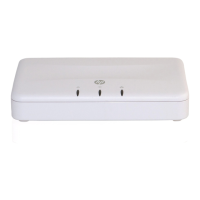Wireless coverage 47
5 Wireless configuration
Wireless coverage
As a starting point for planning your network, you can assume that when operating at high
power, the M210 radio provides a wireless networking area (also called a wireless cell) of up
to 300 feet (100 meters) in diameter. Before creating a permanent installation, you should
always perform a site survey to determine the optimal settings and location for the M210.
The following sections provide information on wireless coverage. A tool that can help simplify
planning a secure wireless network is the HP RF Planner (available separately). For more
information, see the RF Planner Admin Guide or contact your HP Partner.
Factors limiting wireless coverage
Wireless coverage is affected by the factors discussed in this section.
Interference
Interference is caused by other APs or devices that operate in the same frequency band as the
M210 and can substantially affect throughput. Several tools are available to diagnose
interference problems as they occur.
• Select Wireless > Rogue AP detection to view detailed information about all wireless
APs operating in the immediate area so that you can effectively set the operating
frequencies. This feature also makes it easy for you to find rogue APs. See Detecting Rogue
APs on page 60.
• Select Status > Wireless to view detailed information about packets sent and received,
transmission errors, and other low-level events.
Caution APs that operate in the 2.4 GHz band may experience interference from devices including
2.4 GHz cordless phones and microwave ovens. A smaller but growing number of devices are
potential sources of interference in the 5 GHz band.
Physical characteristics of the location
To maximize coverage of an M210, install it in an open area with as few obstructions as
possible. Try to choose a location that is central to the area being served.
Radio waves cannot penetrate metal—they are reflected instead. The M210 can transmit
through wood or plaster walls and closed windows (although window glazing or thickness may
impair penetration). However, the steel reinforcing found in concrete walls and floors may
block transmissions or reduce signal quality by creating reflections. This can make it difficult or
impossible for a single M210 to serve users on different floors in a concrete building. Such
installations require a separate M210 on each floor.

